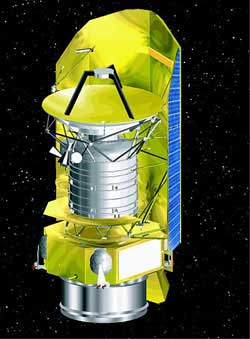Herschel Space Observatory facts for kids
Quick facts for kids Herschel Space Observatory |
|
 |
|
| Organization | European Space Agency (ESA) NASA |
|---|---|
| Location | Lagrangian point L2 |
| Wavelength | 60-670 µm (far-infrared) |
| Telescope style | Ritchey-Chrétien |
| Diameter | 3,500 mm (140 in), f/0.5 (Primary Mirror) |
| Collecting area | 9.6 m2 (103 sq ft) |
| Focal length | 28.5 m (94 ft), f/8.7 |
| Website | herschel.esac.esa.int |
The Herschel Space Observatory is a European Space Agency instrument. It is the largest infrared space telescope ever launched. Herschel is named after Sir William Herschel, the discoverer of the infrared spectrum, double stars, and planet Uranus.
The device is sensitive to the far infrared and submillimetre short wavebands. It has a single mirror of 3.5 metres (11.5 ft) in diameter.
The observatory was carried into orbit in May 2009. It is at the second Lagrangian point (L2) of the Earth-Sun system. At these points, 1,500,000 kilometres (930,000 miles) from the Earth, gravity balances, so the object stays in place.
The Herschel Observatory can record ('see') the coldest and dustiest objects in space. For example, dusty galaxies just starting to form new stars. The United States, through NASA, is working with in the ESA-built and operated observatory. It is the fourth 'cornerstone' mission in the ESA science program, along with Rosetta, Planck, and the Gaia mission.
The instrument has four main aims:
- Galaxy formation in the early universe and the evolution of galaxies;
- Star formation and its interaction with the interstellar medium;
- Chemical composition of atmospheres and surfaces of Solar System bodies, including planets, comets and moons;
- Molecular chemistry across the universe.
Images for kids
-
Animation of Herschel Space Observatory's trajectory from 14 May 2009 to 31 August 2013 Herschel Space Observatory · Earth
-
Animation of Herschel Space Observatory's trajectory around Earth from 14 May 2009 to 31 December 2049 Herschel Space Observatory · Earth
See also
 In Spanish: Herschel (observatorio espacial) para niños
In Spanish: Herschel (observatorio espacial) para niños







